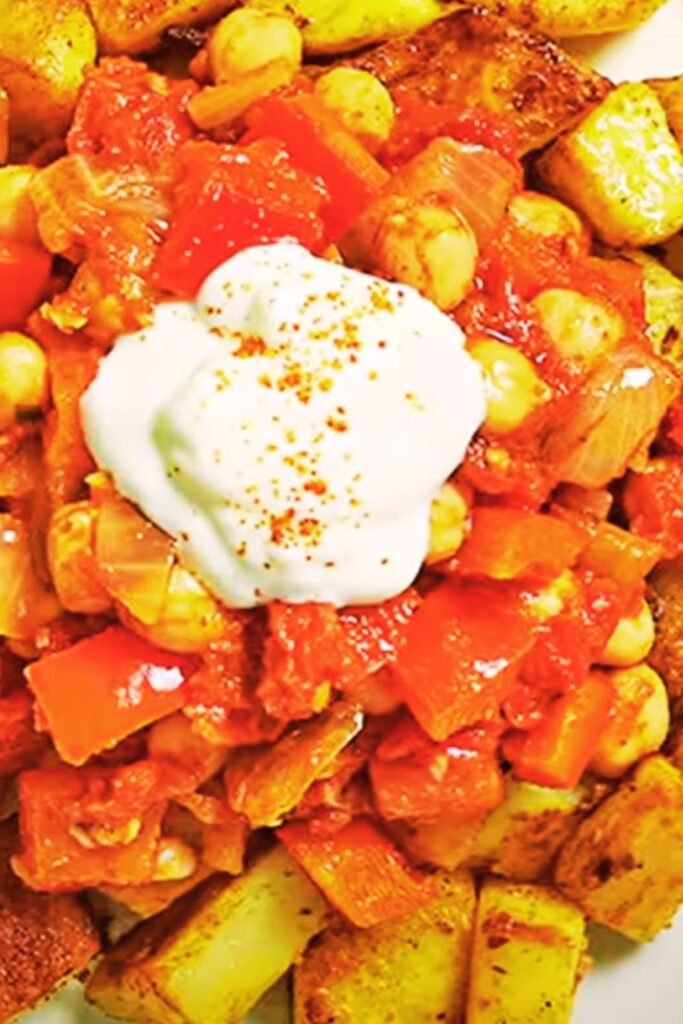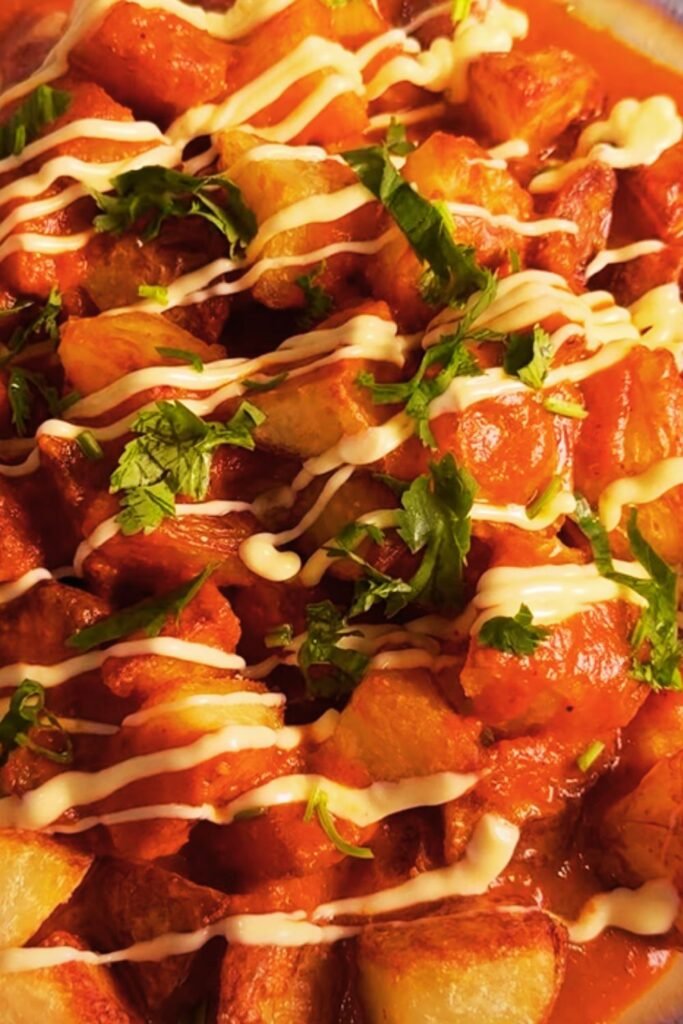There’s something magical about dishes that carry centuries of history in their flavors. As I stand in my kitchen preparing Patatas Mozárabes, I’m not just cooking a meal—I’m connecting with the rich culinary heritage of southern Spain. This humble potato dish tells the story of cultural fusion between the Moorish and Christian traditions that shaped Andalusian cuisine.
What Are Patatas Mozárabes?
Patatas Mozárabes (literally “Mozarabic Potatoes”) are a traditional Spanish dish with roots in medieval Andalusia. The term “Mozárabe” refers to Christians who lived under Moorish rule in the Iberian Peninsula between the 8th and 15th centuries. These communities created a fascinating cultural fusion that’s perfectly embodied in this aromatic potato dish.
At its heart, this recipe combines everyday potatoes with a rich blend of North African and Mediterranean spices, creating something truly extraordinary. The potatoes are slow-cooked with olive oil, garlic, herbs, and a distinctive blend of spices until they absorb every bit of flavor, resulting in a dish that’s simultaneously humble and luxurious.
The Historical Significance of Patatas Mozárabes
Before diving into the recipe itself, I believe it’s worth appreciating the historical significance of this dish. The Mozarabic period represents one of the most fascinating chapters in Spanish history—a time when different religious and cultural traditions coexisted and influenced each other.
The culinary traditions from this era reflect this cultural exchange. While potatoes themselves weren’t introduced to Europe until after the discovery of the Americas (much later than the Mozarabic period), the spice combinations and cooking methods in this dish are authentic to that historical fusion. Today’s version adapts those traditional flavors to incorporate the now-ubiquitous potato.
What makes this dish particularly special is how it preserves flavor combinations that might otherwise have been lost to history. The cinnamon, cumin, and honey that characterize Patatas Mozárabes aren’t typical of modern Spanish cooking but harken back to the Moorish influence on Iberian cuisine.
Ingredients for Authentic Patatas Mozárabes
To create truly authentic Patatas Mozárabes, you’ll need to gather ingredients that bridge two culinary worlds:
- 2 pounds (900g) potatoes – Yellow or gold varieties work best
- 1/4 cup (60ml) extra virgin olive oil – The backbone of Mediterranean cooking
- 4 cloves garlic, finely minced
- 1 large onion, finely diced
- 1 red bell pepper, diced
- 2 bay leaves
- 1 cinnamon stick
- 1 teaspoon ground cumin
- 1/2 teaspoon ground coriander
- 1/4 teaspoon ground cardamom
- A pinch of saffron threads (optional, but traditional)
- 1 tablespoon honey
- 2 tablespoons white wine vinegar
- 1 cup (240ml) vegetable stock
- 1/4 cup chopped fresh cilantro
- 1/4 cup chopped fresh parsley
- 1/4 cup blanched almonds, lightly toasted and roughly chopped
- Salt and freshly ground black pepper to taste
- 1 lemon, cut into wedges for serving
Each ingredient plays a crucial role in building the complex flavor profile that makes this dish so special. The combination of sweet, savory, and aromatic elements creates a truly memorable experience.
Essential Equipment
While Patatas Mozárabes doesn’t require fancy equipment, having the right tools will make preparation much easier:
- Large heavy-bottomed skillet or cazuela (traditional Spanish earthenware pot)
- Sharp knife for precise cutting
- Wooden spoon for gentle stirring
- Measuring spoons and cups
- Small bowl for blooming saffron
- Mortar and pestle (optional but helpful for grinding spices)
I particularly recommend using a traditional clay cazuela if you have one. Not only does it distribute heat beautifully, but it also connects your cooking process to the traditional methods used throughout Spanish history.

Preparation Method
Now that we have our ingredients assembled, let’s walk through the process of creating authentic Patatas Mozárabes:
- Prepare the potatoes: Wash them thoroughly and cut into 1-inch (2.5cm) chunks. You can peel them if you prefer, but I like to keep the skins on for added texture and nutrition.
- Bloom the saffron (if using): Place saffron threads in a small bowl with 2 tablespoons of warm water and let sit for 10 minutes to release their color and flavor.
- Heat the olive oil in your cazuela or heavy skillet over medium heat. Add the onions and cook until translucent, about 5 minutes.
- Add the aromatics: Incorporate the garlic, bay leaves, and cinnamon stick. Cook for another 1-2 minutes until fragrant, being careful not to burn the garlic.
- Add the spices: Stir in the cumin, coriander, and cardamom, toasting them gently in the oil for about 30 seconds to release their aromas.
- Incorporate the potatoes and bell pepper: Add the potato chunks and diced bell pepper to the pot, stirring to coat them with the spiced oil.
- Add liquids: Pour in the vegetable stock, saffron with its soaking water, honey, and vinegar. Season with salt and pepper.
- Simmer gently: Reduce heat to low, cover partially, and simmer for about 30-35 minutes, or until the potatoes are tender when pierced with a fork. Stir occasionally to ensure even cooking.
- Finish the dish: Once the potatoes are tender, remove the bay leaves and cinnamon stick. Taste and adjust seasoning if necessary.
- Garnish and serve: Just before serving, stir in most of the fresh herbs, reserving some for garnish. Sprinkle with toasted almonds and the remaining herbs.
The key to this dish is patience—allowing the potatoes to slowly absorb the flavors as they cook. This isn’t a rushed weeknight meal but rather a celebration of slow food and cultural heritage.
Regional Variations
Like many traditional dishes, Patatas Mozárabes has evolved differently across various regions of Spain. Here are some of the most interesting variations I’ve encountered:
| Region | Variation | Key Ingredients | Cooking Method |
|---|---|---|---|
| Granada | Patatas a lo Pobre | Includes sliced green peppers and sometimes eggs | Slowly fried rather than simmered |
| Córdoba | Patatas Cordobesas | Adds tomatoes and sometimes pieces of serrano ham | Simmered with extra olive oil |
| Seville | Patatas Sevillanas | Incorporates olives and sometimes capers | Similar to the base recipe but with brinier elements |
| Rural Andalusia | Campero Style | Includes wild herbs like thyme and rosemary | Often cooked in outdoor fires in earthenware |
| Coastal Areas | Seafood Variation | Adds small amounts of salt cod or anchovies | Fish elements added near the end of cooking |
Each variation reflects local traditions and available ingredients, while maintaining the core Mozarabic influence that makes this dish so special.
Common Mistakes to Avoid
In my years of preparing this dish, I’ve noticed several common pitfalls that can prevent you from achieving the authentic flavor of Patatas Mozárabes:
- Rushing the cooking process: This dish demands slow cooking to allow the potatoes to absorb all the flavors properly.
- Using too much liquid: The potatoes should simmer in the spiced stock, not boil in it. Too much liquid results in a soupy consistency rather than tender, flavor-infused potatoes.
- Overcrowding the pan: Give your potatoes some space in the pan to ensure they cook evenly.
- Skipping the toasted almonds: These add an essential textural contrast and nutty flavor that complements the soft potatoes.
- Using old spices: The aromatic spices are central to this dish, so make sure yours are fresh and fragrant.
- Over-stirring: While you should stir occasionally to prevent sticking, too much agitation can break down the potatoes and create a mushy texture.
By avoiding these mistakes, you’ll be well on your way to creating an authentic version of this historical dish.

Serving Suggestions
Patatas Mozárabes works beautifully as both a side dish and a main course. Here are my favorite ways to serve it:
- As a tapas dish: Serve in small earthenware dishes with toothpicks for a traditional Spanish tapas experience.
- As a side dish: Pairs wonderfully with grilled meats, especially lamb or chicken seasoned with similar Moorish-inspired spices.
- As a vegetarian main: Serve larger portions accompanied by a simple green salad dressed with olive oil and lemon juice.
- For a complete meal: Top with a fried or poached egg for added richness.
- With bread: Always offer good crusty bread to soak up the flavorful sauce—it’s too delicious to waste!
Traditional Spanish accompaniments like marinated olives, roasted almonds, or thin slices of manchego cheese also complement this dish beautifully.
Make-Ahead and Storage Tips
One of the wonderful aspects of Patatas Mozárabes is that, like many slowly-cooked dishes, the flavors actually improve with time. Here’s how to make the most of that quality:
- Make ahead: Prepare the dish up to 2 days in advance and refrigerate. Reheat gently on the stovetop with a splash of water or stock if needed.
- Storage: Keep leftovers in an airtight container in the refrigerator for up to 4 days.
- Reheating: For best results, reheat slowly in a covered pan with a small amount of liquid to prevent drying out. Alternatively, reheat in a 325°F (165°C) oven in a covered dish.
- Freezing: While possible, freezing isn’t ideal as the texture of the potatoes can become mealy. If you must freeze, do so for no longer than 1 month and thaw slowly in the refrigerator before reheating.
I find that a day in the refrigerator allows the spices to mellow and meld beautifully, creating an even more complex flavor profile when reheated.
Health Benefits
Beyond its delicious taste and cultural significance, Patatas Mozárabes offers several nutritional benefits:
- Potatoes provide complex carbohydrates, vitamin C, potassium, and fiber (especially when cooked with skins on).
- Olive oil contributes heart-healthy monounsaturated fats.
- Spices like cumin, cinnamon, and coriander contain antioxidants and have anti-inflammatory properties.
- Garlic and onions offer immune-boosting compounds and prebiotic benefits.
- Fresh herbs add vitamins A, C, and K, along with additional antioxidants.
- Almonds provide protein, healthy fats, vitamin E, and a satisfying crunch.
The combination of these ingredients creates not just a flavorful dish but also one that incorporates many elements of the heart-healthy Mediterranean diet.
Adapting Patatas Mozárabes for Dietary Needs
This versatile dish can be adapted for various dietary requirements without losing its essential character:
- Vegan option: The base recipe is already vegan if you use vegetable stock. Just substitute maple syrup or agave nectar for the honey.
- Low-sodium version: Use homemade vegetable stock without salt and increase the aromatic herbs and spices to compensate for flavor.
- Lower-fat alternative: Reduce the olive oil to 2 tablespoons and use more stock to maintain moisture.
- Nightshade-free option: Substitute carrots and parsnips for the potatoes and omit the bell pepper. The spice blend will still create that distinctive Mozarabic flavor.
- Low-carb variation: Use cauliflower florets instead of potatoes. Cook for a shorter time (about 15-20 minutes) until tender but not mushy.
With these adaptations, nearly everyone can enjoy a version of this historical dish regardless of their dietary preferences or restrictions.

Cultural Context and When to Serve
Understanding when and why to serve Patatas Mozárabes adds another layer of appreciation to this dish:
- Family gatherings: In Spain, this dish often appears at family meals, particularly Sunday lunches when there’s time to prepare it properly.
- Religious festivals: Some families prepare this dish during Christmas and Easter as part of larger celebratory meals.
- Historical commemorations: In parts of Andalusia, Patatas Mozárabes might be served during festivals celebrating the region’s multicultural history.
- Autumn and winter: The warming spices make this particularly suitable for cooler months, though it’s enjoyed year-round.
I particularly enjoy preparing this dish when hosting friends for a relaxed weekend lunch. Its unique flavor profile always prompts conversations about history and cultural exchange—making it perfect for gatherings where good food and good conversation go hand in hand.
My Personal Connection to Patatas Mozárabes
The first time I tasted authentic Patatas Mozárabes was in a small family-owned restaurant in Granada, nestled in the shadow of the Alhambra palace. The juxtaposition of eating this Moorish-influenced dish while gazing at that magnificent example of Islamic architecture made a profound impression on me.
What struck me was how a simple potato dish could tell such a complex historical story—one of cultural exchange, resilience, and the power of food to preserve heritage across centuries. Since then, I’ve made this dish countless times, each preparation a small homage to that cultural dialogue.
I’ve also found that this recipe provides an excellent opportunity to teach others about Spain’s multicultural history. When friends ask about the unusual combination of cinnamon and potatoes, it opens the door to discussing the rich tapestry of influences that have shaped Spanish cuisine.
Questions and Answers
What does “Mozárabe” mean exactly? The term “Mozárabe” refers to Christians who lived under Muslim rule in the Iberian Peninsula during the medieval period (roughly 8th-15th centuries). These communities maintained their Christian faith while adopting many aspects of Arabic language, culture, and customs—including culinary practices. Their unique cultural position created a fascinating fusion that significantly influenced what we now recognize as Spanish cuisine.
Can I use sweet potatoes instead of regular potatoes? Yes! Sweet potatoes make for a delicious variation that actually enhances the sweet-savory balance characteristic of Moorish cuisine. If using sweet potatoes, reduce the honey to 1-2 teaspoons since sweet potatoes have natural sweetness. Also, they tend to cook more quickly than regular potatoes, so check for doneness around the 20-25 minute mark.
Where can I find authentic Spanish paprika for this recipe? Look for “Pimentón de la Vera” in specialty food stores, Spanish grocers, or online. This smoked paprika comes in sweet (dulce), bittersweet (agridulce), and hot (picante) varieties. For Patatas Mozárabes, the sweet or bittersweet varieties work best to complement the other spices without overwhelming them.
Is this dish normally vegetarian? In its most traditional form, yes, Patatas Mozárabes is vegetarian. However, regional variations sometimes incorporate small amounts of ham or salt cod. The vegetarian version is completely authentic and reflects the dish’s origins in a time when meat was often reserved for special occasions.
How spicy is this dish traditionally? Patatas Mozárabes is aromatic rather than spicy-hot. The warming spices like cinnamon, cumin, and coriander create depth of flavor without adding heat. If you prefer some spicy kick, you can add a pinch of cayenne pepper or a small dried chili during cooking, though this would be a modern adaptation rather than traditional.
Can I cook this in a slow cooker or Instant Pot? Yes, though with some modifications. For a slow cooker, reduce the liquid by about 1/4 cup, sauté the aromatics beforehand, and cook on low for 4-5 hours. For an Instant Pot, use the sauté function for the initial steps, then pressure cook on high for about 5 minutes with natural release. The texture will be slightly different from the traditional stovetop method, but the flavors will still be delicious.
What’s the significance of the almonds in this dish? Almonds are one of the clearest markers of Moorish influence in Spanish cuisine. The Moors introduced almonds and many other nuts to Spain, where they became integral to both sweet and savory cooking. In Patatas Mozárabes, they add texture and protein while connecting the dish to its historical roots.
How can I make this dish the centerpiece of a Moorish-inspired meal? To create a complete Moorish-inspired feast, serve Patatas Mozárabes alongside dishes like lamb tagine with dried fruits, couscous with vegetables, orange and olive salad with mint, and finish with honey-soaked pastries or date-filled cookies. This combination showcases the sweet-savory balance and aromatic spice profiles characteristic of this culinary tradition.
Final Thoughts
Patatas Mozárabes is more than just a potato dish—it’s a delicious lesson in cultural history. Each time I prepare it, I’m reminded of how culinary traditions can preserve aspects of history that might otherwise be forgotten.
The beauty of this dish lies in its accessibility. With simple ingredients and straightforward techniques, anyone can create a taste experience that connects them to centuries of cultural exchange. Whether you’re a history enthusiast, a culinary explorer, or simply someone who appreciates good food, Patatas Mozárabes offers something special.
I encourage you to approach this recipe not just as instructions to follow, but as an invitation to connect with another time and place. As the aromas of cinnamon, cumin, and garlic fill your kitchen, you’re participating in a culinary tradition that has persisted through centuries of change—a testament to the enduring power of food to tell our human stories.
So heat your olive oil, gather your spices, and prepare to embark on a flavorful journey through Spain’s multicultural heritage. Your taste buds—and your dinner guests—will thank you.